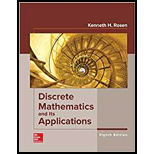
w that ifRandSare bothn-ary relations, then
Want to see the full answer?
Check out a sample textbook solution
Chapter 9 Solutions
DISCRETE MATHEMATICS+ITS APPL. (LL)-W/A
- Let and be lines in a plane. Decide in each case whether or not is an equivalence relation, and justify your decisions. if and only ifand are parallel. if and only ifand are perpendicular.arrow_forwardFor determine which of the following relations onare mappings from to, and justify your answer. b. d. f.arrow_forwardExpress (AB)(AB) in terms of unions and intersections that involve A,A,B,andBarrow_forward
- Does the relation is in love with have a reflexive property consider one person? a symmetric property consider two people? a transitive property consider three people?arrow_forwardVIII.1. Let A = {1,2, 3, 4} and let R, S, T and U be the following relations: R= {(1,3), (3, 2), (2, 1), (4, 4)}, S = {(2,1), (3, 3), (4, 2)}, T = {(4,1), (4, 2), (3, 1), (3, 2), (1, 2)}, U = {(x, y) | x > y}. (a) For each of R, S, T and U determine whether they are functional, reflexive, symmetric, anti-symmetric or transitive. Explain your answer in each case, showing why your answer is correct. (b) What is the transitive closure of R? (c) Explain why R", the transitive closure of R, is an equivalence relation. De- scribe the equivalence classes E, into which the relation partitions the set A. VIII.2. Prove or give a counterexample to the following statement: for any relation R both R and RoR always have the same transitive closure. VIII.3. Is there a mistake in the following proof that any transitive and symmetric relation Ris reflexive? If so, what is it? Let a Rb. By symmetry, bRa. By transitivity, if aRb and bRa, then aRa. This proves reflexivity. VIII.4. Determine for the…arrow_forwardSuppose R and S are relations on {a, b, c, d}, where R = {(a, b), (a, d), (b, c), (c, c), (d, a)} and S = {(a, c), (b, d), (d, a)}. Find R• S.arrow_forward
- Choose the relations that are a functions A) B) D) 21 {(0, 18), (1, 14), (2, 10), (2, 6), (3, 9)} -2 -2 -2 -2 14 6. B. D. 2101 2 24arrow_forward12. Consider the following relations on {1, 2, 3, 4}. R1 = {(2,2), (2,31.2,4).(3,2).(3,3).(3,4)} R2 = {(1,1L(1,2),(2,1).(2,2).(3,3).(4,4)} R3 = {2,4)l4,2)} R4 = {(1,21,(2,3).(3,4)} Rs = {(1,1L(2,2).(3,3).(4,4)} %3D a) Which of these relations are reflexive? Justify your answers. b) Which of these relations are symmetric? Justify your answers. c) Which of these relations are antisymmetric? Justify your answer. d) Which of these relations are transitive? Justify your answers.arrow_forward3. Let A = {1,2, 3} and B = {1,2, 3,4}. The relations R1 = {(1,1), (2,2), (3,3)} and R2 = {(1,1), (1,2), (1,3), (1,4)} can be combined using set operations. Find the following: a. R1 U R2 b. Rị n R2 c. R1 \ R2 d. R2 \ R1arrow_forward
- 6. Q6; Relations (a) Define relations S and R as follows: S = {(a,b), (b, c), (c, d), (b, b)}, R = {(b, a), (c, c), (a, c), (d, b)}. i. Find So S, So R, R- oSo R. Is R-1 OSOR=S? ii. Determine which of S, R, So R, S-1 or R-' is a function.arrow_forward3. Let A = {-1, –3, – 5}, B = {a, B, 7}, C = {x, y, z}. Consider the relations R from A to B and S from B to C respectively. R = {(-1,8), (–3, a), (–3, 7)} and S = {(a, y), (B, x), (7, y), (y, 2)} Find the following relations (a) Find the composition Ro S. (b) Find the matrices MR, Ms and MRos of the respective relations R, S and Ro S. (c) Compare M Ros to the product MRMS.arrow_forwardIn Discrete Matharrow_forward
 Elements Of Modern AlgebraAlgebraISBN:9781285463230Author:Gilbert, Linda, JimmiePublisher:Cengage Learning,
Elements Of Modern AlgebraAlgebraISBN:9781285463230Author:Gilbert, Linda, JimmiePublisher:Cengage Learning, Elementary Geometry for College StudentsGeometryISBN:9781285195698Author:Daniel C. Alexander, Geralyn M. KoeberleinPublisher:Cengage Learning
Elementary Geometry for College StudentsGeometryISBN:9781285195698Author:Daniel C. Alexander, Geralyn M. KoeberleinPublisher:Cengage Learning Linear Algebra: A Modern IntroductionAlgebraISBN:9781285463247Author:David PoolePublisher:Cengage Learning
Linear Algebra: A Modern IntroductionAlgebraISBN:9781285463247Author:David PoolePublisher:Cengage Learning Algebra: Structure And Method, Book 1AlgebraISBN:9780395977224Author:Richard G. Brown, Mary P. Dolciani, Robert H. Sorgenfrey, William L. ColePublisher:McDougal Littell
Algebra: Structure And Method, Book 1AlgebraISBN:9780395977224Author:Richard G. Brown, Mary P. Dolciani, Robert H. Sorgenfrey, William L. ColePublisher:McDougal Littell



